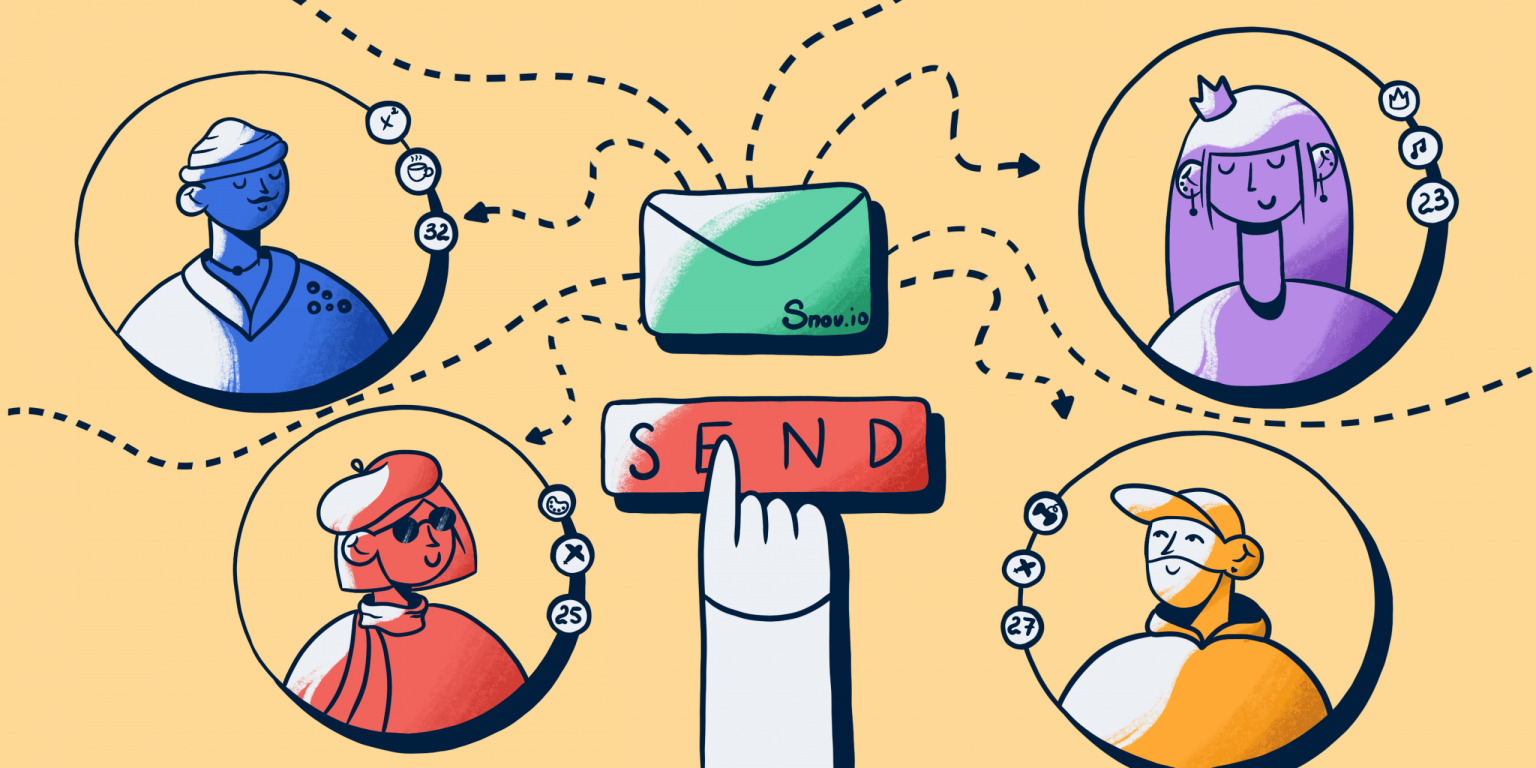Зміст:
Якщо ви читаєте це, то напевно знаєте, що персоналізація листів — це серйозний бустер для ваших email-кампаній.
Згідно зі статистикою від Experian, одержувачі відкривають персоналізовані листи на 25% частіше, ніж будь-які інші. Ще одне дослідження, проведене платформою Dynamic Yield в 2017 році, виявило, що понад 80% респондентів прихильніше ставляться до листа, якщо він виглядає так, як ніби написаний спеціально для них.
Але для того, щоб писати дійсно особисті листи вам необхідно знати не тільки ім’я та прізвище вашого одержувача, а ще й:
- Робочий регіон
- Посаду
- Назву компанії
- Особисті уподобання та антипатії
Детальне розуміння того, чого хоче ваш потенційний клієнт і що ви можете йому запропонувати — найефективніший спосіб персоналізувати ваш email.
Крок 1: Підбираємо джерело інформації
Для створення індивідуальних листів можуть використовуватися будь-які дані про потенційних клієнтів: від улюбленого кавового бренду до уподобань у робочому ПО. Але щоб забезпечити узгодженість цієї інформації вам потрібно вибрати джерело, що оптимально підходить для вашого бізнесу (B2B або B2C), продукту, масштабу кампанії тощо.
Соцмережі
Facebook, X та інші популярні платформи — невичерпне джерело корисних даних про те, чим займаються ваші ліди, де вони працюють та як відпочивають. Більш того, ці дані оновлюються та доповнюються на регулярній основі самими користувачами. Завдяки цьому ви можете досконально вивчити поведінку ваших потенційних клієнтів та дізнатися, що їх засмучує, радує чи надихає.
Пам’ятайте: соціальна активність людини — відмінний показник його відкритості до діалогу: люди, які своєчасно відповідають на меседжві в X, з більшою ймовірністю дадуть вам відповідь на лист, ніж ті, хто нехтує месседжами від підписників.
Підодить для: вузько-таргетованих кампаній, аналізу ЦА, B2B та B2C сегментів.
LinkedIn — ключове джерело даних про професійні навички людей. Тільки тут ви зможете дізнатися про їхній досвід, досягнення, посади та багато іншого.
Ще одна безцінна категорія даних з LinkedIn — Рекомендації. Їх розміщують співробітники або роботодавці власника аккаунта. Завдяки ним можна краще зрозуміти характер людини, його звички та робочі якості.
І ще дещо. Як тільки ваш ідеальний клієнт буде знайдений, ви зможете розширити список потенційних лідів за рахунок так званих контактів 2-го та 3-го рівнів (знайомі знайомих…). Цей пул проспектів, як правило, досить широкий навіть для кампаній великого масштабу, тому ви зможете значно збільшити охоплення своєї ЦА.
Підходить для: B2B, кампаній будь-яких масштабів.
Quora
Ця платформа питань та відповідей зазвичай використовується маркетологами, які просувають свої продукти та послуги у ТОПі пошукової видачі Google. Однак, Quora також може бути потужним інструментом, який допоможе провести аналіз цільової аудиторії та знайти потенційних клієнтів, співробітників та партнерів у B2B для подальшої персоналізації розсилок.
Працює це таким чином: ви шукайте компанії, які активно просувають свій продукт за запитами, що відносяться до вашої діяльності. Потім робите їм вигідну пропозицію, і з високою ймовірністю вони її розглянуть.
Не забувайте також використовувати Quora, для досконалого вивчення болей цільової аудиторії та аналізу її проблем. Це дозволить оптимізувати таргетинг та підвищити показники email-кампаній.
Підходить для: B2B, вузько-таргетованих кампаній, аналізу ЦА.
Інші джерела
Четвірки Facebook, X, LinkedIn і Quora цілком достатньо, щоб зібрати значну кількість даних про ваших потенційних клієнтів. Але якщо ви хочете копнути глибше та краще зрозуміти ваших цільових підписників, можна спробувати й менш очевидні варіанти: Reddit, Telegram або Feedly.
Тут, як і у випадку з Quora, можна шукати теми, пости в блогах, питання та відповіді завдяки яким буде простіше складати бази для розсилки, підбирати тригери та робити ваші листи більш особистими на основі:
- Допустимих та заборонених дій (стоп-слова, недоречні зауваження тощо)
- Больових місць вашої ЦА
- Симпатій, антипатій та захоплень ідеальних лідів
Підходить для: аналізу ЦА.
Невеличкий лайфхак: використовуйте розширення Email Finder від Snov.io у професійних соцмережах та на сайтах компаній. З його допомогою ви можете знайти електронну пошту цікавлячих вас лідів, регулярно збільшувати свою базу контактів та групувати дані про лідів для запуску персоналізованих кампаній.
Крок II: Аналізуємо отриману інформацію
Уже на цьому етапі потрібно впевнено знати:
- Вашого ідеального ліда (на кого ви орієнтуєте пропозицію)
- Масштаб email-кампанії
- Категорії даних, які ви будете використовувати для персоналізації листів
І якщо ваша цільова аудиторія зазвичай встановлюється ще до початку лідогенерації, два інших параметра не настільки очевидні.
Як знайти цільового клієнта
Залежно від особливостей вашого бізнесу, його цільовою аудиторією може бути як людина, так і інший бізнес. Для оптимізації та уточнення орієнтування обов’язково сегментує свою ЦА та працюйте з вузькими групами потенційних клієнтів по точках перетину інтересів.
Як вибрати масштаб email-кампанії
Як правило, B2B-кампанії мають вужче охоплення, ніж B2C сегмент. Це пов’язано з тим, що рішення для бізнесу зазвичай більш вузькопрофільні та коштують дорожче. Крім того, просування продуктів для компаній та детальний аналіз цільової аудиторії вимагають додаткових інвестицій.
Але майте на увазі, що персоналізація B2B-кампаній, орієнтованих на малий бізнес, аналогічна B2C-персоналізації. Так відбувається тому, що невеликий бізнес — це згуртовані команди фахівців, які вміють цінувати доброзичливий, індивідуальний підхід без формальностей. Щоб створити для них оптимальну пропозицію, потрібно точно знати, з якими труднощами стикається їхній бізнес, а також бути максимально впевненими в тому, що можете допомогти у вирішенні цих труднощів.
В цілому, така персоналізація — це дослідження та підбір декількох параметрів особистих даних, завдяки чому утворюється щільний зв’язок з клієнтами.
Для порівняння, у великих розсилках зазвичай використовується всього один елемент персоналізації, окрім імені одержувача. Але не забувайте, тут все повністю залежить від вас — ви обмежені тільки часом та уявою.
Які категорії даних використовувати
Золотий стандарт персоналізації — ім’я та назва компанії, якщо це доречно. Однак ваш email може включати будь-які знайдені дані для створення дійсно особистого повідомлення. Тільки не перестарайтеся: відправка глибоко індивідуальних листів з надмірним обсягом даних про людину може викликати обурення або навіть переляк.
Намагайтеся не виглядати сталкером. Зрозуміло, ви можете досконально вивчити свого потенційного клієнта, але в спілкуванні використовуйте тільки таку інформацію, яка підкреслює його цінність для вас.
Крок III: Пишемо персоналізованого листа
Отже, дані про ваших потенційних лідів зібрано, проаналізовано, згруповано і зараз саме час писати особистий лист для кожного знайденого контакту. І для цього вам слід забути про все, що ви коли-небудь чули відносно стандартних методів холодної розсилки, оскільки ця інформація здатна обмежити вашу уяву.
У першу чергу виключіть кліше та готові шаблони — вони здатні погубити цікаві ідеї у самому корені. Іноді може бути доречним вікористовувати персональний тригер для кожного отримувача, проте це стосується швидше невеликих кампаній з вузькою специфікою пропозицій.
Що ж стосується контенту, то ваш лист має виглядати як живий, особистий діалог з одержувачами. Для цього потрібно використовувати свої знання про їх поведінку та вподобання. Вибираючи такий підхід ви зможете коректно структурувати свій меседж і зробити текст легким та привабливим.
Ім’я
Ім’я та прізвище — основи персоналізації, тому ви повинні навчитися доречно прописувати їх у кожному листі з розсилки. Зупинимося на цій тезі докладніше.
У першу чергу запам’ятайте, що в тригерні листи не потрібно вписувати ім’я та прізвище одночасно. Імена більше підходять для дружнього, невимушеного звернення («Привіт, Аркадій»), а прізвища — для листів в офіційному тоні («Вітаю, пані Кравченко»).
Оптимальний варіант для наступного параметра персоналізації — назва компанії. Це покаже вашому одержувачу, що ви цікавитеся його роботою та серйозно налаштовані на діалог для подальшої співпраці.
Зверніть увагу, що в наших прикладах ми використовуємо змінні у фігурних дужках: {{firstName}}, {{lastName}} та {{companyName}}. Ці позначення можуть відрізнятися у різних відправників, тому зіставте їх з тими, які ви використовуєте у своїх кампаніях.
Привіт, {{firstName}}!
У вашому профілі на LinkedIn я помітив, що ви фахівець з маркетингу в {{companyName}}. Я стежу за вашою компанією деякий час і звернув увагу на її стрімке зростання.
А зростання означає масштабування. Саме тому я, як маркетолог, хочу порекомендувати вам Snov.io для автоматизації пошуку та перевірки email-адрес.
Ви напевно добре знаєте, що кожна знайдена вручну адреса електронної пошти з LinkedIn або сайтів ваших потенційних клієнтів потребує значних часових та ресурсних витрат. Так чому б не довірити її швидкому та доступному інструменту? Snov.io за дві секунди згенерує та перевірить списки адрес для ваших кампаній.
Хочете, щоб я надіслав вам демо роботи інструментів?
З найкращими побажаннями,
Олег Скрипка, маркетолог Snov.io
Постарайтеся відчути больові місця ваших потенційних клієнтів. Покажіть, що ви розумієте своїх підписників та знаєте, з якими проблемами стикається ваша цільова аудиторія щодня.
Посада або кваліфікація
Корисний лайфхак: використовуйте інформацію про посади ваших потенційних клієнтів або їх кваліфікацію, щоб робити їм професійні компліменти. Наприклад, якщо один з ваших лідів написав статтю на свою професійну тему, згадка про неї — відмінний спосіб вказати на його видатні досягнення у цій галузі. У цьому випадку ви можете зробити його статтю однієї зі змінних у вашому листі.
Привіт, {{firstName}}!
Вивчав ваш блог, натрапив на статтю {{articleHeadline}}, і повинен сказати, що вона без сумніву варта витраченого на неї часу та проведених досліджень.
Ви так захоплені маркетингом, що напевно знаєте ціну кожній хвилині. Тому інструмент для тригерної розсилки від Snov.io може допомогти вам автоматизувати кампанії, заощадивши дорогоцінні робочі години.
Ви можете запустити свої email-кампанії прямо зараз та використати будь-який шаблон листа для розсилки з нашої великої бібліотеки.
Хочете подивитися демо праці інструменту?
З найкращими побажаннями,
Лесь Подерв’янський, маркетолог Snov.io
Зрозуміло, цей сценарій підходить тільки для невеликої кампанії. Однак така увага та непідробний інтерес зачарують ваших проспектів.
Знову Quora
Ще один сценарій на випадок, якщо вам вдасться зібрати достатньо особисті дані про потенційного ліда, але не поштову адресу: відзначте його питання або коментарі з Quora посиланням в листі. Якщо компанія відповість на нього зі свого корпоративного аккаунту, ви зможете знайти пошту потрібного представника відділу на їхньому сайті за допомогою розширення для пошуку пошти.
І не забувайте тепло відгукуватися про відповідь компанії, досвід її співробітників та їх чуйність. Це відмінний спосіб для укладення вигідного партнерства.
Пости в X
Доречно також застосовувати інформацію про активність користувачів у соціальних мережах, щоб підкреслити їх унікальність. Таким чином ваші цільові клієнти зрозуміють, що ви дійсно цікавитеся їхньою думкою. Сміливо посилайтеся на пости в X та репости своїх потенційних клієнтів у листі або використовуйте посилання на них в якості змінної. Завдяки цьому ваші розсилки також стануть більш живими та цікавими для отримувачів.
Пам’ятайте
У вашому розпорядженні уся зібрана вами інформація, тому керуйтеся нею доречно. Наприклад, згадуючи у листі суто особисті дані (ім’я собаки, модель авто тощо), Переконайтеся, що вона має безпосереднє відношення до вашого продукту.
І навпаки: не пишіть про улюблене ТВ-шоу свого потенційного клієнта, якщо ви продаєте медичне обладнання; не згадуйте про модель його смартфона, якщо ваше завдання — продати товари для домашніх тварин. Це буде виглядати моторошно.
Ключова ідея персоналізації — бачити в кожному потенційного клієнті особистість і використовувати тільки доречну, актуальну та точну інформацію про нього.
Крок IV: Запускаємо тригерну email-кампанію
Персоналізація не обмежується єдиним відправленим листом. Ви повинні відправляти повідомлення своїм передплатникам відштовхуючись від їх реакції на вашу кампанію. І тут на допомогу приходять тригерні розсилки та сервіси для їх автоматизації.
Важливо, щоб ваш передплатник отримував різні відповіді у залежності від того, чи відкриє він перший лист, чи перейде за посиланням у ньому, чи проігнорує ваш месседж.
Більше про тригерні кампанії та рішення для їх автоматизації від Snov.io ви можете дізнатися тут.
Післямова
Отже, ми з’ясували, що таке персоналізація та чому вона настільки важлива для email-кампаній. Але щоб написати персоналізований лист у 2024 році, вам варто проявити винахідливість. Не обмежуйте себе у творчості, але й не забувайте про:
- Акцент на якості, а не на кількості листів
- Використання тільки актуальних даних
- Природність та дружелюбність
- Повсякденний стиль у спілкуванні задля створення емоційної прив’язки
Завдяки цим правилам ви побудуєте персоналізацію на підставі взаєморозуміння та довіри до своєї аудиторії.




